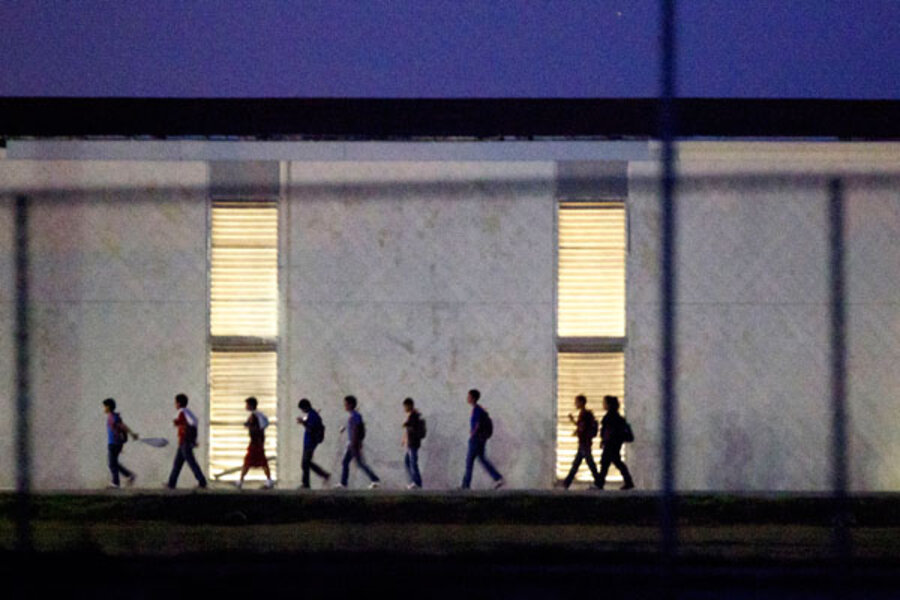Illegal immigration dilemma: Are migrant children refugees or criminals?
Loading...
The growing crush of vulnerable migrant children crossing the Rio Grande and entering the US through south Texas has put urgency to a vexing question for the US immigration system:
Are children fleeing Central American violence refugees who need asylum or illegal gold-diggers who need to go home?
The rush on the border has created what the White House and many others have called a humanitarian crisis. But it has also pushed Washington into finger-pointing mode, with politicians and commentators trying to pin down why children, often guided by “coyote” smugglers, are traveling hundreds of miles across Mexico into the US.
The massive border breach by “unaccompanied alien children” has been building since 2012, going from 6,560 in fiscal year 2011 to an estimated 90,000 this year, and a possible 150,000 in 2015. Of those, as many as two-thirds should qualify as legitimate refugees because their fears of persecution in their home countries – whether from gangs or political factions – seem to be well-founded, according to a report by the United Nations High Commissioner for Refugees (UNHCR).
Whether they will be is an open question for America’s unique asylum system, where protection-seekers can now linger for years before a judge determines whether they face a reasonable fear of persecution or violence in their home country.
The UNHCR, in a February report, claimed most of the children are fleeing violence and political persecution in Guatemala, El Salvador, and Honduras, the country with the highest murder rate in the world, according to the UN Office of Drugs and Crime. The report also notes that the bulk of asylum-seekers aren’t coming to the US, but instead seeking protection from countries like Mexico, Belize, Costa Rica, and Nicaragua.
In the US, however, the influx of young migrants – and images of crowded detention facilities – comes amid a potent and divisive national debate about immigration reform and what it means for American security and the economy. That pits humanitarian needs against politics.
“The key here is that this is an opportunity for us to step up and stick to American principles and traditions of being a nation that accepts refugees, that protects human rights, and enforces our laws that say we will provide asylum to people that meet the criteria,” says Michelle Brané, who directs the Women’s Refugee Commission’s migrant rights and justice program. Opposing that are “gut responses that say, ‘How do you stop all these kids from getting into the US?’ and claims that the US border is too open and too lax and too welcoming of these populations.”
In 2003, federal care for unaccompanied children crossing the border was moved from the law enforcement branch of the former Immigration and Naturalization Service to the Department of Health and Human Services. Since then, the US has taken extra care when looking at asylum requests from unaccompanied minors. A 2008 human trafficking law also added protections.
But recent reports from the UN and the Center for Gender and Refugee Studies in San Francisco suggest that child asylum-seekers, especially those who come alone, should be afforded greater protections, as well as better representation. For example, current law doesn’t mandate children receive a lawyer to argue their case.
The US is a signatory to a 1951 UN refugee treaty that says anyone who crosses the border and shows signs of being at risk cannot be sent back until their circumstances have been investigated thoroughly.
“We’re not dealing with groups of people here who are not entitled to US protection,” says James Hathaway, the director of the Program in Refugee and Asylum Law at the University of Michigan in Ann Arbor. “Quite the contrary, we’re dealing with a population that actually seems to in very large measure qualify for protection that we offered to provide by signing the UN Refugee Convention.”
But there remains skepticism among many citizens, lawmakers, and federal immigration judges about the true roots of the migration – which could strengthen if the crisis deepens. Many say the children are not as much fleeing as being drawn by rumors that the Obama administration will protect child migrants. By letting more child border-crossers stay in the US, it would create incentive for more illegal immigrants to try their luck on the US border, they argue.
They note that the current surge began in 2012, when President Obama signed an executive action that allowed undocumented immigrants who were brought to the country as minors to defer deportation proceedings for two years. Last week, the administration announced plans that would allow these immigrants to defer their deportations a further two years.
None of the unaccompanied minors crossing the border illegally now would qualify. Mr. Obama’s actions apply only to undocumented immigrants who came to the US before June 15, 2007. But coyotes won’t care about the finer details.
“Word has gotten out around the world about President Obama’s lax immigration enforcement policies and it has encouraged more individuals to come to the United States illegally, many of whom are children,” Rep. Bob Goodlatte (R) of Virginia, chairman of the House Judiciary Committee, said in a statement.
Those concerns could further impact an asylum system that Professor Hathaway says is “clearly one of the worst” in the world. “So the concern that [what appears a crisis on the border] can have negative ramifications on asylum-seekers is probably well founded.”








